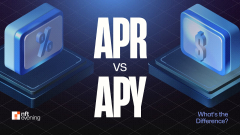APR and APY might look quite similar, but they measure different things. Knowing what they mean can help you make better financial choices, especially in the context of cryptocurrency.
What is APR?
APR, or Annual Percentage Rate, is the amount it costs to borrow money over a year. In crypto, it’s commonly used for loans or staking rewards. It’s just the interest rate alone, but it doesn’t factor compounding into APR.
For instance, if you borrow a crypto loan of $1,000 with a 10% APR, you will have to pay $100 in interest after one year. That is without additional fees or compounding.
In DeFi, APR often gets applied to borrowing or lending tokens. If you’re lending out stablecoin with an APR of 5%, in a year’s time, that’s 5% of principal. But remember, APR does not consider how often you get paid or how reinvesting those payments can grow your returns.
What affects your APR?
Many things can determine your APR, for example:
- Credit Score: If you have a good credit score, you’ll get a low APR, but if you have a bad credit score, you might get a high APR.
- Loan Type: Various loans carry different APRs. For instance, a mortgage will have a lower APR compared to a credit card.
- Lender: For the same type of loan, various banks or lenders may provide different APRs.
- Loan amount and term: The amount you borrow and how long you take to repay it can change the APR. So, shorter loans may have lower APRs.
- Market Rates: If interest rates in the economy increase, your APR may increase.
- Down Payment: The more significant the down payment, the better the APR given by the lender.
APR vs. Interest rate
APR and interest rates are similar but not the same. The interest rate is the base rate, while APR includes fees. For example, if you take a crypto loan with a 5% interest rate and a 2% platform fee, the APR becomes 7%. APR helps borrowers understand the total cost of borrowing.
What is APY?
APY, or Annual Percentage Yield, will measure how much you earn on your savings or investment, with the compounding interest. Compounding occurs when the interest you are earning is added to your original amount and then that total earns interest on it. In crypto, compounding may happen daily, weekly, or monthly depending on a given platform.
For example, if you deposited $1,000 in cryptocurrency into a savings account with a 5% APY, compounded monthly, you’ll earn a bit above $50 for a year. This is because every month, your earnings are added to your balance, raising the amount that future interest gets computed on.
APY vs. interest rate
The interest rate only reflects the simple annual return, whereas APY takes into account compounding. For instance, a 10% APY with monthly compounding will be slightly higher than a 10% annual interest rate. That is why APY is more useful for understanding actual returns.
APR vs. APY: What is the difference?
| APR (Annual Percentage Rate) | APY (Annual Percentage Yield) | |
| Definition | Measures the annual cost of borrowing or return on investment, excluding compounding | Measures the annual return on investment, including compounding |
| Compounding | No | Yes |
| Usage in Crypto | Loans and staking rewards | Yield farming, staking, and savings. |
| Calculation | Simple interest over a year | Compound interest over a year, considering the frequency of compounding |
| Impact on Costs/Returns | Straightforward estimate of costs or returns | More accurate representation of returns with compounding |
| Example (Borrowing) | Borrow $1,000 at 10% APR, and pay $100 in interest in one year | Borrow $1,000 at 10% APY, and pay slightly more due to compounding |
| Example (Saving) | Stake $1,000 at 10% APR, and earn $100 in one year | Stake $1,000 at 10% APY, and earn slightly more due to compounding |
| Relevance | Better for understanding borrowing costs | Better for understanding investment growth |
Example
Here’s an example to understand the difference between APR and APY:
- Borrowing: If you take a $1,000 crypto loan at a 12% APR, you’ll owe $120 in interest after a year. However, if compounding is applied monthly, and the rate is expressed as APY, your total cost could be closer to $126.
- Saving: If you deposit $5,000 in a staking pool offering a 12% APY with monthly compounding, your returns will exceed $600 due to the added effect of compounding.
The Borrower’s Perspective
The annual percentage rate (APR) is the most important figure to pay attention to when borrowing. It’s the figure that lets you see what the average baseline cost of a loan is. For example, if you borrowed 5,000 USD in stablecoins at an APR of 12%, you know that, assuming there isn’t compounding, you’ll have $600 in interest owed after one year.
However, borrowing in crypto is not that simple. Although APR gives a simple picture, many platforms apply compounding, which makes the actual cost higher than the quoted APR. In such cases, the effective interest rate is more similar to the APY. Borrowers need to carefully look at loan agreements for terms like “compounding frequency” or “effective rate” to avoid surprises.
Additionally, crypto lending markets are influenced by the volatility and liquidity of the assets involved. If you are borrowing highly volatile cryptocurrencies, the platform may adjust rates dynamically. APR in such scenarios might shift, leading to variable borr





